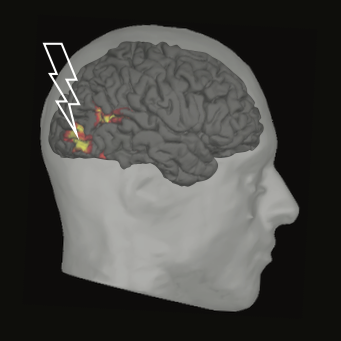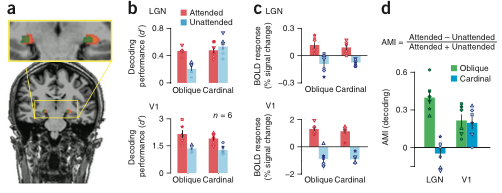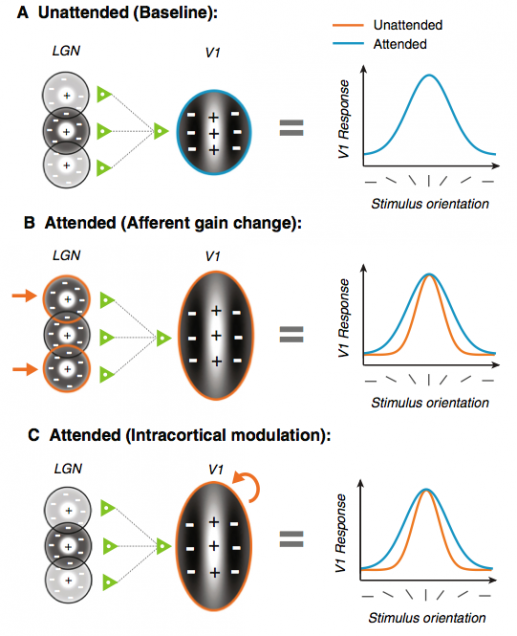Category: Publications
The Occipital Face Area is Causally Involved in Facial Viewpoint Perception
Journal of Neuroscience (2015)
Tim Kietzmann, Sonia Poltoratski, Peter König, Randolph Blake, Frank Tong & Sam Ling

Humans reliably recognize faces across a range of viewpoints, but the neural substrates supporting this ability remain unclear. Recent work suggests that neural selectivity to mirror-symmetric viewpoints of faces, found across a large network of visual areas, may constitute a key computational step in achieving full viewpoint invariance. In this study, we used repetitive transcranial magnetic stimulation (rTMS) to test the hypothesis that the occipital face area (OFA), putatively a key node in the face network, plays a causal role in face viewpoint symmetry perception. Each participant underwent both offline rTMS to the right OFA and sham stimulation, preceding blocks of behavioral trials. After each stimulation period, the participant performed one of two behavioral tasks involving presentation of faces in the peripheral visual field: judging the viewpoint symmetry or judging the angular rotation. rTMS applied to the right OFA significantly impaired performance in both tasks when stimuli were presented in the contralateral, left visual field. Interestingly, however, rTMS had a differential effect on the two tasks performed ipsilaterally. While viewpoint symmetry judgments were significantly disrupted, we observed no impact on the angle judgment task. This interaction, caused by ipsilateral rTMS, provides support for models emphasizing the role of inter-hemispheric crosstalk in the formation of viewpoint-invariant face perception.
New opinion piece by Dongho, Sam and Takeo Watanabe in F1000 Research!
New opinion paper on the relationship between rewards and perceptual learning.
Kim, D., Ling, S., & Watanabe, T. (2015)
Dual mechanisms governing reward-driven perceptual learning.
F1000 Research
Great writeup, Dongho!
Attention alters orientation processing in the human lateral geniculate nucleus
Nature Neuroscience (2015)
Sam Ling, Michael Pratte & Frank Tong
Orientation selectivity is a cornerstone property of vision, commonly believed to emerge in the primary visual cortex (V1). Here, we demonstrate that reliable orientation information can be detected even earlier, in the human lateral geniculate nucleus (LGN), and that attentional feedback selectively alters these orientation responses. This attentional modulation may allow the visual system to modify incoming feature-specific signals at the earliest possible processing site.
A review of the mechanisms by which attentional feedback shapes visual selectivity
Brain, Structure & Function (In Press)
Sam Ling, Janneke Jehee & Franco Pestilli
The glut of information available for the brain to process at any given moment necessitates an efficient attentional system that can ‘pick and choose’ what information receives prioritized processing. A growing body of work, spanning numerous methodologies and species, reveals that one powerful way in which attending to an item separates the wheat from the chaff is by altering a basic response property in the brain: neuronal selectivity. Selectivity is a cornerstone response property, largely dictating our ability to represent and interact with the environment. Although it is likely that selectivity is altered throughout many brain areas, here we focus on how directing attention to an item affects selectivity in the visual system, where this response property is generally more well characterized. First, we review the neural architecture supporting selectivity, and then discuss the various changes that could occur in selectivity for an attended item. In a survey of the literature, spanning neurophysiology, neuroimaging and psychophysics, we reveal that there is general convergence regarding the manner with which selectivity is shaped by attentional feedback. In a nutshell, the literature suggests that the type of changes in selectivity that manifest appears to depend on the type of attention being deployed: whereas directing spatial attention towards an item only alters spatial selectivity, directing feature-based attention can alter the selectivity of attended features.



